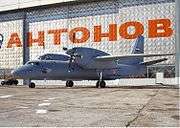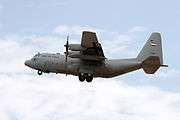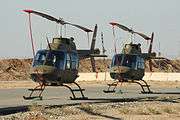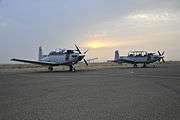Iraqi Air Force
| Iraqi Air Force القوة الجوية العراقية | |
|---|---|
|
Air Force roundel | |
| Founded | April 22, 1931 |
| Country |
|
| Branch | Air force |
| Size | Approximately 5,000[1] |
| Anniversaries | April 22 (Air Force Day)[2] |
| Equipment | 260 aircraft[3] |
| Engagements |
Anglo-Iraqi War |
| Commanders | |
| Current commander | General Hamid al-Maliki |
| Insignia | |
| Fin flash |
 |
| Air Force Ensign |
 |
| Aircraft flown | |
| Attack | Su-25, L-159 |
| Fighter | F-16IQ |
| Reconnaissance | CH 2000, Ce 208 ISR, KA 350 ISR |
| Trainer | Ce172, Ce 208, T-6A, Bell 206B, OH-58C, Utva Lasta 95 |
| Transport | C-130E, C-130J, An-32B, KA 350ER, Mi-17, UH-1H |
The Iraqi Air Force (IQAF or IAF; Arabic: القوة الجوية العراقية, Al Quwwa al Jawwiya al Iraqiya) is the aerial warfare service branch of the Iraqi Armed Forces, responsible for the policing of international borders and surveillance of national assets. The IQAF also acts as a support force for the Iraqi Navy and the Iraqi Army and it allows Iraq to rapidly deploy its developing Army.
The Iraqi Air Force was founded in 1931, during British rule of Iraq, with only a few pilots. Aside from a brief period during the Second World War, the Iraqi Air Force operated mostly British aircraft until the 14 July Revolution in 1958, when the new Iraqi government began increased diplomatic relationships with the Soviet Union. The air force used both Soviet and British aircraft throughout the 1950s and 1960s. When Saddam Hussein came to power in 1979, the air force grew very quickly when Iraq ordered more Soviet and French aircraft. Its peak came after the long and bloody Iran–Iraq War, which ended in 1988, when it consisted of 1027 aircraft, becoming the largest air force in the region. Its downfall came during the Gulf War (1990–91) and continued while coalition forces enforced no-fly zones. The remains of Iraq's air force were destroyed during the 2003 invasion of Iraq. After the invasion, the IQAF was rebuilt, receiving most of its training and aircraft from the United States.
History
The Royal Iraqi Air Force (RIrAF) considered its founding day as 22 April 1931, when the first pilots flew in from training in the United Kingdom.[2] Before the creation of the new air force, the RAF Iraq Command was in charge of all British Armed Forces elements in Iraq in the 1920s and early 1930s.[4] The RIrAF was based at the airport in the Washash neighborhood of Baghdad, and consisted of five pilots, aeronautics students trained at the RAF College Cranwell, and 32 aircraft mechanics.[2] The original five pilots were Natiq Mohammed Khalil al-Tay, Mohammed Ali Jawad, Hafdhi Aziz, Akrem Talib Mushtaq, and Musa Ali.[2] During the early years of the Royal Iraqi Air Force, it mainly received aircraft from the United Kingdom as well as Breda Ba.65 attack planes and SM-79 bombers from Italy.[4]
In the years following Iraqi independence, the Air Force was still dependent on the Royal Air Force. The Iraqi government allocated the majority of its military expenditure to the Iraqi Army and by 1936 the Royal Iraqi Air Force had only 37 pilots and 55 aircraft. The following year, the Air Force showed some growth, increasing its number of pilots to 127.[5]
1930s to 1950s

The RIrAF was first used in combat against the revolts by tribes in Diwaniya and Rumaytha southern Iraq in 1934 under order of Bakr Sidqi, where it suffered its first combat loss. Its first combat against another conventional military was in the 1941 Anglo-Iraqi War when the Iraqi government made a bid for full independence following a coup by Rashid Ali against pro-British Iraqi leaders. The RIrAF was destroyed as a fighting force, resulting in an alliance with the Axis which involved Luftwaffe aircraft (painted in Iraqi markings) and Italian Regia Aeronautica aircraft assisting Iraqi ground forces. The German units were Special Staff F and Fliegerführer Irak. However losses, a lack of spares and replacements resulted in their departure, following which the coup was defeated by British forces.
A roughly 1946 order of battle for the Air Force can be found in Jane's Fighting Aircraft of World War II.
The RIrAF was still recovering from its destruction by the British in 1948[4] when they joined in the war against the newly created state of Israel in the 1948 Arab–Israeli War.[4] Even though the RIrAF now had some modern aircraft, the RIrAF played a small role in the first war against Israel. From 1948 to 1949 the RIrAF operated Avro Anson training-bombers from Jordan from where they flew a number of attacks against the Israelis.[4] Some of the Ansons were replaced by the modern Hawker Fury fighter however these aircraft flew only two missions against Israel in Iraqi markings before most were transferred to the Egyptians.[4] 14 Hawker Furies had been delivered but by June 7, 1948 only 6 remained operational.[4] Despite these early problems the RIrAF purchased more Furies, acquiring a total of 38 F.Mk.1s single seaters and 4 two-seaters.[4] which equipped numbers 1 and 7 Squadrons RIrAF. The only RIrAF Fury victory was an Israeli Boeing B-17 Flying Fortress bomber.
1950s and early 1960s

During the 1950s, the RIrAF was affected when the monarchy was toppled in 1958, resulting in the cessation of arms imports from western countries such as Great Britain.[4] From 1950 to 1958 most of the RIrAF aircraft were from the United Kingdom. The first jet fighters, the de Havilland Vampire of the RIrAF, were delivered in 1953. The RIrAF also received de Havilland Venoms and Hawker Hunters during the mid-1950s.[4] In 1954 and 1956, 19 de Havilland Vampire jet fighters and 14 ex-RAF Hawkers funded by the U.S. were delivered.[4] They also received 4 Bristol 170 Freighters in 1953.[4]
During the 14 July Revolution in 1958, the King of Iraq was overthrown and the country established diplomatic and political relationships with Warsaw Pact countries, while simultaneously severing relations with western nations.[4] The Iraqi Air Force (IQAF) dropped the "Royal" from its name after the revolution.[4] The Soviets were quick to supply MiG-17s, and later MiG-19 and MiG-21 fighters, as well as Ilyushin Il-28 bombers to the new Iraqi government.[4] They also received 13 Ilyushin Il-14 transports in 1959 from Poland. The first MiG-17s were first delivered in 1958 to replace the de Havilland Vampire. During the late 1960s and or early 1970s additional MiG-17 examples may have been purchased and then forwarded to either Syria or Egypt.[4]
Tom Cooper and Stefan Kuhn list the air force's squadrons in 1961 as:[6]
- No. 1 Squadron IqAF, Venom FB.Mk.1, based at Habbaniyah AB, CO Capt. A.-Mun'em Ismaeel
- No. 2 Squadron IqAF, Mi-4, based at Rashid AB, CO Maj. Wahiq Ibraheem Adham
- No. 3 Squadron IqAF, An-12B, based at Rashid AB, CO Capt. Taha Ahmad Mohammad Rashid
- No.4 Squadron, Fury FB.Mk.11, based at Kirkuk Air Base, CO Maj. A. Latif
- No.5 Squadron, MiG-17F, based at Rashid AB, CO Maj. Khalid Sarah Rashid
- No.6 Squadron, Hunter, based at Habbaniyah AB, CO Capt. Hamid Shaban
- No.7 Squadron, MiG-17F, based at Kirkuk, CO Maj. Ne'ma Abdullah Dulaimy
- No.8 Squadron, Il-28, based at Rashid AB, CO Maj. Adnan Ameen Rashid
- No.9 Squadron, MiG-19, in process of formation.
The IQAF received about 50 MiG-19s during the early 1960s but most of these remained in their crates and were subsequently re-delivered to Egypt and only the 6th squadron ever operated the (roughly) 18 MiG19P and missile armed MiG19PMs, which it did from Rasheed Air Base in Baghdad. Iraq also received MiG21F-13 fighters in 1962 and Tu-16 bombers after 1963.
The November 1963 Iraqi coup d'état realigned Iraq with NATO powers, and as a result, more second-hand Hawker Hunters were delivered to the IQAF.[4] Aircraft imports from the Communist Eastern European nations had been suspended until 1966, when MiG-21PF interceptors was purchased from the Soviet Union[4] after the death in an aircraft accident of Abdelsalam Aref, the Iraqi president, who was then replaced by his brother.
In 1966, Iraqi Captain Munir Redfa defected with his MiG-21F-13 to Israel who in turn gave it to the United States for evaluation under the code-name "Have Donut".[7] However, by then the MiG21-F13s had been replaced by MiG21FL and PFM in the Iraqi air force's frontline units and the MiG21-F13s were being used as operational conversion trainers.
Six-Day War
During the Six-Day War, the IQAF bombed several air bases and land targets, including strikes by Tu-16 bombers on Israeli airbases. One of the striking bombers was shot down by Israelis, but the rest returned safely. The IQAF also played a significant role in supporting Jordanian troops.[2] As well, the Iraqi Air Force had one Pakistani pilot Saiful Azam who claimed two kills of Israeli fighters over H3 in an Iraqi Hawker Hunter. Iraqi pilots in Hawker Hunters made a further five claims against Israeli planes in air combat.[4] Due to Hunters and MiG21PFMs the IQAF were successfully able to defend their air bases in western Iraq from additional Israeli attacks.[4] On the same day the IQAF also were able to break through Israeli air space and destroyed five Israeli aircraft in air fighting.[2]
1970s and the Yom Kippur War
Throughout this decade, the IQAF grew in size and capability, as the 20 year Treaty of friendship with the USSR signed in 1971 brought large numbers of relatively modern fighter aircraft to the air force. The Iraqi government was never satisfied with the Soviets alone supplying them, and while they were purchasing modern fighters like the MiG-21 and the Sukhoi Su-20, they began persuading the French to sell Mirage F-1s fighters (which were bought) and later Jaguars (which were however never ordered).[4]
Before the Yom Kippur War, the IQAF sent 12 Hawker Hunters to Egypt where they stayed to fight; only 1 survived the war.[4] The IQAF first received their Sukhoi Su-7s in 1968; they were originally stationed in Syria. Aircraft deployed to Syria suffered heavy losses due to Israeli aircraft and SAMs. In addition, they were hit with friendly fire from Syrian SAMs.[8] A planned attack on the 8th of October was canceled due to these heavy losses as well as disagreements with the Syrian government. Eventually, all aircraft besides several Sukhoi Su-7s were withdrawn from bases in Syria. During the war in October 1973, the first air strike against Israeli bases in Sinai was composed of Iraqi planes; they hit artillery sites and Israeli tanks, and they also claimed to have destroyed 21 Israeli fighters in air combat.[9] Shortly after the war, the IQAF ordered 14 Tu-22Bs and two Tu-22Us from the USSR as well as Raduga Kh-22 missiles from Soviet Union and by 1975, 10 Tu-22Bs and 2 Tu-22Us were delivered.[10]
The 1970s also saw a series of fierce Kurdish uprisings in the north of the country against Iraq.[11] With the help of the Shah of Iran, the Kurds received arms and supplies including modern SAMs as well as some Iranian soldiers.[12] The IQAF suffered heavy casualties fighting the Kurds, so they began using their new Tu-22s in combat against them (using 3 tonne bombs from high altitude to avoid the Iranian HAWK SAM batteries that the Shah had set up near the Iraqi border to cover the Kurdish insurgents) as they were able to avoid a greater percentage of SAMs due to their higher bombing altitude and improved electronic countermeasures.[4] During the mid-1970s, tensions with Iran were high but were later resolved with the Algiers Treaty.

1980s and war with Iran
Between the autumn of 1980 and the summer of 1990, the number of aircraft in the IQAF went from 332 to over 1000.[2] Before the Iraqi invasion of Iran, the IQAF had expected 16 modern Dassault Mirage F.1EQs from France and were also in the middle of receiving a total of 240 new aircraft and helicopters from their Eastern European allies. When Iraq invaded Iran in late September 1980, the Soviets and the French stopped delivery of additional aircraft to Iraq but resumed deliveries a few months later.[13]
The IQAF had to instead fight with obsolete Su-20, MiG-21 Fishbeds and MiG-23 Floggers.[13] The MiG-21 was the main interceptor of the force while their MiG-23s were used for ground attack and interception. The Su-20 were pure ground attack aircraft. On the first day of the war, formations of Tu-16/22s, Su-20s, MiG-23s and MiG-21s, for a total of 166 aircraft, raided airports and airfields of the Iranian Air Force, but the Iranian aircraft were not damaged because of strong concrete hangars that housed the planes. In retaliation for these aerial attacks, the Iranian Air Force launched Operation Kaman 99 a day after the war was launched.
During late 1981, it was soon clear that the modern Mirage F-1s and the Soviet MiG-25s were effective against the Iranians.[13] The IQAF began to use their new Eastern weaponry which included Tu-22KD/KDP bombers, equipped with Kh-22M/MP air-to-ground missiles, MiG-25s equipped with Kh-23 air-to-ground missiles as well as Kh-25 and Kh-58 anti-radar missiles and even MiG-23BNs, equipped with Kh-29L/T missiles.[13] In 1983, to satisfy the Iraqis waiting for their upgraded Exocet-capable Mirage F-1EQ5s, Super Etendards were leased to Iraq. The Iranian oil tanker fleet (see Tanker War) and gunboats suffered severe damage at the hand of the 5 Super Etendards equipped with Exocet anti-ship missiles. One of these was lost during their 20-month combat use and 4 returned to the Aeronavale in 1985.[13]

The IQAF generally played a major role in the war against Iran. It bombed airfields, military infrastructure, industrial infrastructure such as factories, powerplants and oil facilities, as well as systematically bombing urban areas in Tehran and other major Iranian cities (later came to be known as the War of the Cities). At the end of the war, in conjunction with the army and special operations forces, the IQAF played a significant role in routing Iran's last military offensive.[2] (by that time, the role of the once superior Iranian Air Force had been reduced to missions in desperate situations only, performing critical tasks such as defending Iran's vital oil terminals). The air force also had a successful role attacking tankers and other vessels using Exocet missiles on their Mirage F-1s. On May 17, 1987, an Iraqi F-1 mistakenly launched two Exocet anti-ship missiles into the American frigate USS Stark, crippling the vessel and killing 37 sailors.[2]
By 1987, the air force consisted of 40,000 men, of whom about 10,000 were a part of the Air Defense Command.[2] Its main base was in Tammuz (Al Taqqadum), Al Bakr (Balad), Al Qadisiya (Al Asad), Ali Air Base, Saddam Airbase (Qayarrah West Air Base) and other major bases including Basra. The IQAF operated from 24 main operating bases and 30 dispersal bases, with nuclear-hardened shelters and extensive runways.[2]
Notable Iraqi pilots of the Iran–Iraq War
Unlike many other nations with modern air forces, Iraq was engaged in an intense and protracted war. The 8 year long conflict with Iran gave the Air Force the opportunity to develop some battle-tested and hardened fighter pilots. Though information about the IQAF is, at best, hard to access, two men stand out as the best Iraqi fighter aces.
Mohommed Rayyan, nicknamed "Sky Falcon," who flew MiG-21 MFs in 1980-81, and claimed two confirmed kills against Iranian F-5Es in 1980. With the rank of Captain, Rayyan qualified on MiG-25Ps in late 1981 and went on to claim another eight kills, two of which are confirmed, before being shot down and killed by IRIAF F-14s in 1986.[14]
Captain Omar Goben was another successful fighter pilot. While flying a MiG-21 he scored air kills against two F-5E Tiger IIs and one F-4E Phantom II in 1980. He later transferred to the MiG-23 and survived the war, but was killed in January 1991 flying a MiG-29 versus an American F-15C.[14]
1990s – Persian Gulf War and no-fly zones
In August 1990, Iraq had the largest air force in the region even after the long Iran–Iraq War. The air force at that time had 910 combat aircraft in its inventory. Theoretically, the IQAF should have been 'hardened' by the conflict with Iran, but post-war purges of the IQAF leadership and other personnel decimated the air force, as the Iraqi regime struggled to bring it back under total control.[13] Training was brought to a minimum during the whole of 1990.
The table below shows the Iraqi Air Force at the start of the Persian Gulf War, its losses, damaged aircraft, flights to Iran and remaining assets at the end of the Persian Gulf War. A portion of the aircraft damaged may have been repairable or else used for spare parts. This is a combination of losses both in the air (23 aircraft)[15] and on the ground (227 aircraft) and exclude the helicopters and aircraft that belonged to Iraqi Army Aviation, Iraqi Navy and the Aviation wing of the Iraqi Department of Border Enforcement.[16]
| Aircraft | 1990 | destroyed | damaged | to Iran | survived |
|---|---|---|---|---|---|
| Dassault Mirage F1EQ/BQ | 88 | 23 | 6 | 24 | 35 |
| Dassault Mirage F1K (Kuwaiti) | 8 | 2 | 2 | 0 | 4 |
| Sukhoi Su-20 | 18 | 4 | 2 | 4 | 8 |
| Sukhoi Su-22R | 10 | 1 | 0 | 0 | 9 |
| Sukhoi Su-22M2 | 24 | 2 | 6 | 5 | 11 |
| Sukhoi Su-22M3 | 16 | 7 | 0 | 9 | 0 |
| Sukhoi Su-22UM3 | 25 | 3 | 1 | 0 | 21 |
| Sukhoi Su-22M4 | 28 | 7 | 0 | 15 | 6 |
| Sukhoi Su-24MK | 30 | 5 | 0 | 24 | 1 |
| Sukhoi Su-25 | 72 | 31 | 8 | 7 | 26 |
| Mikoyan-Gurevich MiG-21/F7 | 236 | 65 | 46 | 0 | 115 |
| Mikoyan-Gurevich MiG-23BN | 38 | 17 | 0 | 4 | 18 |
| Mikoyan-Gurevich MiG-23ML | 39 | 14 | 1 | 7 | 17 |
| Mikoyan-Gurevich MiG-23MF | 14 | 2 | 5 | 0 | 7 |
| Mikoyan-Gurevich MiG-23MS | 15 | 2 | 4 | 0 | 9 |
| Mikoyan-Gurevich MiG-23UM | 21 | 8 | 0 | 1 | 12 |
| Mikoyan-Gurevich MiG-25U | 7 | 3 | 2 | 0 | 2 |
| Mikoyan-Gurevich MiG-25RB | 9 | 3 | 3 | 0 | 3 |
| Mikoyan-Gurevich MiG-25PDS | 19 | 13 | 1 | 0 | 5 |
| Mikoyan-Gurevich MiG-29A | 37 | 17 | 4 | 3 | 13 |
| Mikoyan-Gurevich MiG-29UB | 4 | 0 | 0 | 1 | 3 |
| Tupolev Tu-16 | 3 | 3 | 0 | 0 | 0 |
| Xian H-6 | 4 | 4 | 0 | 0 | 0 |
| Antonov An-26 | 5 | 0 | 3 | 0 | 2 |
| Ilyushin Il-76 | 19 | 3 | 1 | 15 | 0 |
| Dassault Falcon 20 | 2 | 0 | 0 | 2 | 0 |
| Dassault Falcon 50 | 3 | 0 | 0 | 3 | 0 |
| Lockheed Jetstar | 6 | 4 | 0 | 1 | 1 |
| Aero L-39 Albatros | 67 | 0 | 1 | 0 | 66 |
| Embraer Tucano | 78 | 1 | 6 | 0 | 64 |
| FFA AS-202 Bravo | 34 | 5 | 5 | 0 | 17 |
| Eloris trainer | 12 | 0 | 0 | 0 | 12 |
| BAC Jet Provost | 15 | 0 | 0 | 0 | 15 |
| MBB/Kawasaki BK 117 | 14 | 1 | 6 | 0 | 6 |
During the 1991 Persian Gulf War, the Iraqi Air Force was devastated by the United States, the United Kingdom and their allies. Most airfields were heavily struck, and in air combat Iraq was only able to obtain four confirmed kills (and 4 damaged and one probable kill), while sustaining 23 losses.[15] All of the out of service (six) Tupolev Tu-22s that Iraq possessed were destroyed by bombing at the start of Operation Desert Storm, though they had already been withdrawn from the inventory of the Iraqi Air Force and were simply used as decoys and do not appear on the operational list of lost aircraft from the Iraqi Air Force (like all other old aircraft which were used solely to deflect raids from operational assets).
The MiG-25 force (NATO reporting name 'Foxbat') recorded the first air-to-air kill during the war. A MIG-25PDS, piloted by Lt. Zuhair Dawood of the 84th Fighter Squadron, shot down an U.S. Navy F/A-18 Hornet from VFA-81 on the first night of the war. In 2009 the Pentagon announced they had identified the remains of the pilot, U.S. Navy Captain Michael "Scott" Speicher, solving an 18-year mystery. Captain Speicher, who was a Lieutenant Commander at the time, was apparently buried by nomadic Bedouin tribesmen close to where his jet was shot down in a remote area of Anbar province.
The second air-air kill was recorded by a pilot named Jameel Sayhood on January nineteenth. Flying a MIG-29, he shot down a Royal Air Force Tornado GR.1A with R-60 missiles. The RAF aircraft serial ZA396/GE was piloted by Flight Lieutenant D J Waddington, and Flight Lieutenant R J Stewart, and crashed 51 nautical miles southeast of Tallil air base.[17]
In another incident, an Iraqi Mikoyan-Gurevich MiG-25 eluded eight USAF F-15C Eagles, firing three missiles at a USAF EF-111 electronic warfare aircraft, forcing them to abort their mission. In yet another incident, two MiG-25's approached a pair of F-15 Eagles, fired missiles (which were evaded by the F-15s), and then out-ran the American fighters. Two more F-15s joined the pursuit, and a total of ten air-to-air missiles were fired at the Foxbats; none of which could reach them.
In an effort to demonstrate their own air offensive capability, on 24 January the Iraqis attempted to mount a strike against the major Saudi oil refinery in Abqaiq. Two Mirage F-1 fighters laden with incendiary bombs and two MiG-23s (along as fighter cover) took off from bases in Iraq. They were spotted by USAF Boeing E-3 Sentry AWACS aircraft, and two Royal Saudi Air Force F-15s were sent to intercept. When the Saudis appeared the Iraqi MiGs turned tail, but the Mirages pressed on. Captain Ayedh Al-Shamrani, one of the Saudi pilots, maneuvered his jet behind the Mirages and shot down both aircraft. After this episode, the Iraqis made no more air efforts of their own, sending most of their jets to Iran in hopes that they might someday get their Air Force back. (Iran returned seven Su-25s in 2014.)[18]
The ethnic Assyrian Air Vice Marshal Georges Sada was sacked and imprisoned by Saddam Hussain for refusing to execute prisoners of war.
During the Persian Gulf War, most Iraqi pilots and aircraft (of French and Soviet origin) fled to Iran to escape the bombing campaign because no other country would allow them sanctuary. The Iranians impounded these aircraft after the war and returned seven Su-25s in 2014, while putting the rest in the service of the Islamic Republic of Iran Air Force[19] – claiming them as reparations for the Iran–Iraq War. Because of this Saddam Hussein did not send the rest of his Air Force to Iran just prior to Operation Iraqi Freedom in 2003, instead opting to bury them in sand. Saddam Hussein, preoccupied with Iran and regional power balance, is reported to have commented: "The Iranians are even stronger than before, they now have our Air Force."[20]
These included: Mirage F1s, Su-20 and Su-22M2/3/4 Fitters, Su-24MK Fencer-Ds, Su-25K/UBK Frogfoots, MiG-23 Floggers, MiG-29A/UB Fulcrums and a number of Il-76s, including the one-off AEW-AWACS prototype Il-76 "ADNAN 1". Also, prior to Operation Desert Storm, 19 Iraqi Mig-21s and MiG-23s were sent to Yugoslavia for servicing, but were never returned due to international sanctions.[21] In 2009, the Iraqi government briefly sought the return of the fighters, but they were disassembled and would have been costly to repair and return.[21][22][23]
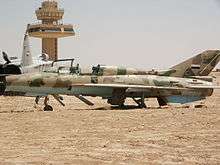
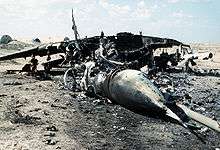
Persian Gulf War aircraft losses claimed by coalition forces
| Aircraft | Origin | No. Shot Down | No. To Iran |
|---|---|---|---|
| Mikoyan-Gurevich MiG-21 | USSR | 4 | 0 |
| Mikoyan-Gurevich MiG-23 | USSR | 9 | 12 |
| Mikoyan-Gurevich MiG-25 | USSR | 2 | 0 |
| Mikoyan-Gurevich MiG-29 | USSR | 6 | 4 |
| Dassault Mirage F-1 | France | 9 | 24 |
| Sukhoi Su-7/17 | USSR | 4 | 0 |
| Sukhoi Su-20 | USSR | 0 | 4 |
| Sukhoi Su-22 | USSR | 2 | 40 |
| Sukhoi Su-24 | USSR | 0 | 24 |
| Sukhoi Su-25 | USSR | 2 | 7 |
| Ilyushin Il-76 | USSR | 1 | 15 |
| Mil Mi-8 | USSR | 1 | 0 |
| Observation helicopter | 1 | 0 | |
| U/I helicopter | 1 | 0 | |
| Total Number Loss[24] | 44 | 137 |
The Iraqi air force itself lists its air-to-air losses at 23 airframes[15] compared to the US claims of 44. Similarly, the Allies initially acknowledged no losses in air combat to the Iraqi air force, and only in 1995 acknowledged one loss. After 2003 the Allies acknowledged a second loss, but a further two Iraqi claims and one probable are still listed by the Allies as lost to "ground fire" rather than an Iraqi fighter. Generally at least three Iraqi pilots are relatively agreed upon to have scored victories against coalition aircraft in aerial combat.
As well as the Persian Gulf war, the IQAF was also involved in the 1991 uprisings in Iraq. Alongside Army aviation, Mi-8, Mi-24, Gazelle, Alouette and Puma helicopters were used to counter the attempted Shi'ite and Kurdish revolts between 1991 and 1993.
After the Gulf War, the air force consisted only of a sole SU-24 (nicknamed "waheeda" in the Iraqi airforce which translates to roughly "the lonely") and a single squadron of MiG-25s purchased from the Soviet Union in 1979. Some Mirages, MiG-23MLs and SU-22s also remained in use, with the MiG-29s being withdrawn from use by 1995 due to engine TBO limits, and the MiG-21s withdrawn due to obsolescence. During the period of sanctions that followed, the Air Force was severely restricted by no-fly zones established by the coalition and by restricted access to spare parts due to United Nations sanctions. Many aircraft were unserviceable and a few were hidden from American reconnaissance to escape potential destruction. In patrols of the no-fly zones, three Iraqi MiGs were lost. Despite several attacks from U.S. F-15s and F-14s firing AIM-54 and AIM-120 missiles at the Iraqi fighters, the Iraqi maneuvers ensured they were able to avoid any casualties in their dispute over Iraqi airspace. The last recorded air-to-air kill was on 23 December 2002, when a MiG-25 Foxbat shot down an armed American RQ-1 Predator.[25]
In 2008, the Defense Technical Information Center released the top-secret archives of the Saddam-era Iraqi Air Force, shedding light on the true losses and operations of the Air Force during 1991.[16]
Operation Iraqi Freedom (OIF) – 2003
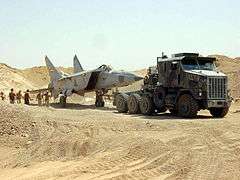
By 2003, Iraq's air power numbered an estimated 180 combat aircraft, of which only about half were flyable.[26] In late 2002, a Yugoslav weapons company provided servicing for the MiG-21s and MiG-23s, violating UN sanctions.[26] An aviation institute in Bijeljina, Bosnia and Herzegovina, supplied the engines and spare parts.[27] These however, were too late to improve the condition of Iraq's air force.
On the brink of the US led invasion, Saddam Hussein disregarded his air force's wishes to defend the country's airspace against coalition aircraft and ordered the bulk of his fighters to be disassembled and buried. Some were later found by US excavation forces around the Al Taqqadum and Al Asad air bases, including MiG-25s and Su-25s.[28] The IQAF proved to be totally non-existent during the invasion; a few helicopters were seen but no fighters flew to combat coalition aircraft.[29]
During the occupation phase, most of Iraq's combat aircraft (mainly MiG-23s, MiG-25s and Su-25s) were found by American and Australian forces in poor condition at several air bases throughout the country while others were discovered buried.[30] Most of the IQAF's aircraft were destroyed during and after the invasion, and all remaining equipment was junked or scrapped in the immediate aftermath of the war. None of the aircraft acquired during Saddam's time remained in service.[24]
Post-invasion
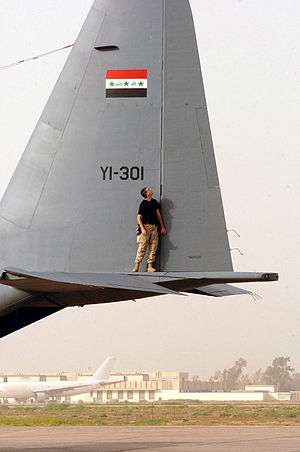
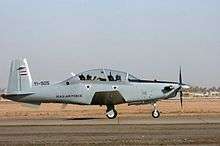
The Iraqi Air Force, like all Iraqi forces after the 2003 Invasion of Iraq, was rebuilt as part of the overall program to build a new Iraqi defense force.[31] The newly created air force consisted only of 35 people in 2004 when it began operations.[32]
In December 2004, the Iraqi ministry of defense signed two contracts with the Polish defence consortium BUMAR.[33] The first contract, worth 132 million USD, was for the delivery of 20 PZL W-3 Sokół helicopters and the training of 10 Iraqi pilots and 25 maintenance personnel.[33] They were intended to be delivered by November 2005, but in April 2005 the company charged with fulfilling the contract announced the delivery would not go ahead as planned, because the delivery schedule proposed by PZL Swidnik was not good enough.[33] As a result, only 2 were delivered in 2005 for testing.
The second contract, worth 105 million USD, consisted of supplying the Iraqi air force with 24 second-hand Russian-made, re-worked Mi-17 (Hips).[33] As of 2008, 8 had been delivered and 2 more were on their way. The Mi-17s were reported to have some attack capability.[34]

During this period, the Air Force primarily served as a light reconnaissance and transport operation.[35] On March 4, 2007, the IQAF carried out its first medical evacuation in the city of Baghdad when an injured police officer was airlifted to a hospital.[36]
In 2007, the USAF's Second Air Force, part of Air Education and Training Command, was given responsibility to provide curricula and advice to the Iraqi Air Force as it stood up its own technical training and branch specific basic training among others. This mission was known as "CAFTT" for Coalition Air Forces Training Team.[31][35]
During the Battle of Basra (2008) the Iraqi Air Force planned, executed, and monitored 104 missions in support of Iraqi ground security forces in Basra during Operation Charge of the Knights in the Basra area between March 25 and April 1.[37]
In 2009 the first of several Iraqi officers completed their flying training at RAF Cranwell, a development with echos of the Iraqi Air Force's early beginnings.[38]

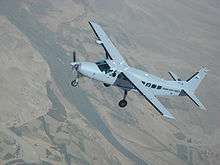
It was reported in December 2007 that a deal had been reached between the Iraqi government and Serbia for the sale of arms and other military equipment including 36 Lasta 95 basic trainers.[39] It was speculated that Iraq might buy 50 Aérospatiale Gazelle attack helicopters from France.[40] In July 2008, Iraq had formally requested an order for 24 light attack and reconnaissance helicopters. The aircraft would either be the U.S. Army's new ARH-70 helicopter or the MH-6 Little Bird.[41]
On October 14, 2008, Aviation Week reported that two Hellfire-equipped Cessna 208Bs were spotted at an ATK facility in Meacham Airport, Fort Worth, Texas. The Iraqi air force was due to receive 3 armed Cessna 208Bs in December 2008, with two more to be delivered in 2009. This represented the first IQAF strike capability since the start of the war in 2003.[42] The Iraqi government announced in November 2008 that the Iraqi Air Force would purchase 108 aircraft through 2011. Ultimately the force was to have consisted of up to 516 total aircraft by 2015, then 550 total aircraft by 2018. Specific types being purchased included Eurocopter EC 635 and Bell ARH-70 type helicopters. Additionally, 24 T-6 Texan II aircraft would be purchased for the light attack role.[43]
Over the summer of 2008, the Defense Department announced that the Iraqi government wanted to order more than 400 armored vehicles and other equipment worth up to $3 billion, and six C-130J transport planes, worth up to $1.5 billion.[44]
Iraq was due to buy 28 Czech-made L-159 training jets valued at $1 billion (770 million euros). Twenty-four of the planes would be new, while four would come from Czech surplus stocks. Later the deal fell through. However afterwards the Czech aviation company Aero Vodochody reportedly agreed to sell 12 of the jets, although the deal wasn't yet approved by both countries' governments.[45] There were talks to buy Czech made combat aircraft Aero L-159 ALCA with possible sale or oil trade of either 24 or 36 aircraft from Czech Air Force surplus.[46][47][48] The purchase was not done and as of 2013, the Czech Republic has not been able to secure its first export deal for its L-159 Alca fighter aircraft.[49] The deal for 24/36 Czech L-159 aircraft was cancelled; instead South Korea supersonic KAI T50 have been chosen (24 aircraft). But in April 2014, Iraq decided to buy 12 second-hand (conserved) L-159 for $200 million.[50]
2010s
Throughout 2010 and 2011, the Iraqi government and the MoI announced intentions to buy Dassault Mirage F1 and F-16C Block 52 fighters.[51][52][53] The Iraqi cabinet specified a sum of $900m as a first installment of $3b worth of aircraft, equipment, spare parts, and training.
The deal to buy the F-16 fighters seemed to teeter as the GoI reversed its decision on the 12th of February and wanted to divert the initial sum of $900m to economic reconstruction.[54][55] However, on the 12 July 2011, the GoI re-iterated its interest in the F-16s due to the pending withdrawal of American forces from Iraq, and later the number of fighters to be purchased was doubled to 36.[56][57][58][59]
Iraq's air space was unguarded from December 2011 until 18 F-16IQ Block 52 jet fighters and their pilots were ready.[60][61][62] The first Iraqi F-16 made its inaugural flight in May 2014.[63] It was officially delivered to the IQAF in a ceremony at Fort Worth, Texas on 5 June 2014.[64]
In October 2012, it was reported that Russia and Iraq may sign a $4.2–$5.0 billion weapons contract, including 30 Mi-28N helicopters.[65] The deal was confirmed on 9 October.[66] The deal was reportedly cancelled due to Iraqi concerns of corruption,[67] but that concern was addressed, and the Iraqi defense minister stated that "the deal is going ahead."[68][69] Despite early complications, all parts of the $4.2 billion contracts were signed, and are being executed. The first contract for 10 Mi-28NE helicopters for Iraq will begin delivery in September 2013.[70] A batch of 13 Mi-28NE helicopters was delivered in January 2014.[71]
On 26 June 2014, Prime Minister Nouri al-Maliki said that they "should have sought to buy other jet fighters like British, French and Russian", describing the order of American F-16s as "long-winded" and "deluded".[72] The IQAF instead acquired second-hand jet aircraft from Russia and Belarus to combat ISIS militants in Northern Iraq, with the first batch arriving on 28 June.[72][73] The Iraqi Ministry of Defense confirmed the purchase of 5 Russian Sukhoi Su-25, uploading a video on its YouTube channel of their arrival.[74] The Islamic Republic of Iran Air Force also delivered seven Su-25s on 1 July, the majority of which were ex-Iraqi aircraft that fled to Iran during the Gulf War.[75]
On 13 July 2015, the Iraqi Air Force received its first batch of F-16 fighters.[76] In addition to the F-16's which are due to be delivered to the Iraqi Air Force throughout the upcoming years, 24 KAI T-50 Golden Eagles are expected to begin deliveries by April 2016 boosting the Iraqi Air Force's defense capabilities.[77] On 5 November 2015, the first two Czech Aero L-159 light combat aircraft were delivered to Iraq.[78][79] The first group of Iraqi pilots completed training in the Czech company Aero Vodochody on 9 February 2016. Iraq will gain a total of 15 Aero L-159s and Aero Vodochody will make 12 aircraft operable for the Iraqi Air Force. Two other planes will be used for the reconstruction of two aircraft into two-seaters, one will be used for spare parts.[80] For nearly three years, United Kingdom has blocked the sale of L-159s because they contain British radar warning receiver. However, Prime Minister David Cameron agreed to overturn the ban in February 2016 and the sale to Iraq is proceeding.[81]
In December 2014, during a meeting between leaders of Iraq and the United Arab Emirates, the UAE offered up to 10 Mirage 2000 fighters to the Iraqi Air Force. The aircraft could have been delivered by March 2015.[82]
Air Force commanders
- 1936, Muhammed Ali Jawad[5]
- 1941, Mahmud Salman[83]
- 1955, Brigadier Sami Fattah[84]
- 1959, Jalal Al-Awqati
- 1963, Hardan al-Tikriti[85]
- 1965, Arif Abdul-Razak
- 1968, Jassam Mohammed al-Shahir[86]
- 1973–1976, Nima Al Dulaimi
- 1978–1983, Mohamed Jessam Al-Jeboury
- 1985, Air Marshal Hamid Sha'aban[87]
- 1990 Muzahim Sa'b Hassan al-Tikriti[88]
- Khaldoon Khattab
- mid-1990s to 2003, Hamid Raja Shalah[89]
- 2005–2008 Kamal Barzanji
- 2008–present Anwar Hamad Amin
Current aircraft
|
See also
Notes
- ↑ "Iraqi Air Force". Arab Aviation. Retrieved 10 July 2016.
- 1 2 3 4 5 6 7 8 9 10 11 "Iraqi Air Force". Global security IQAF. globalsecurity.org. 2005. Retrieved 2008-08-28.
- ↑ "Iraq Military Strength". Retrieved 10 July 2016.
- 1 2 3 4 5 6 7 8 9 10 11 12 13 14 15 16 17 18 19 20 21 22 23 Cooper, Tom (2003). "Iraqi Air Force Since 1948 Part 1". Air Combat Information Group. Retrieved 2008-08-26.
- 1 2 Al-Marashi, Ibrahim; Salama, Sammy (2008). Iraq’s Armed Forces. Routledge. p. 35. ISBN 0-415-40078-3.
- ↑ Tom Cooper and Stefan Kuhn, Kuwait Emergency, Air Combat Information Group, accessed January 2014.
- ↑ "Stealing a Soviet MiG". Jewish virtual library (2005). Retrieved 2008-09-14.
- ↑ Pike, John. "Air Operations During The 1973 Arab-Israeli War And The Implications For Marine".
- ↑ Kenneth M. Pollack, ed. (2002) [1997]. "IRAQ". Arabs At War. 1. University of Nebraska Press. p. 167.
- ↑ "Trade Registers".
- ↑ "Saddam Hussein And Iraqi Air Power".
- ↑ Karsh Rautsi, Efraim Inari (2002). Saddam Hussein A Political Biography. Campaign. New York: Grove Press. p. 81. ISBN 978-0802139788.
- 1 2 3 4 5 6 Cooper, Tom (2003). "Iraqi Air Force Since 1948 Part 2". Air Combat Information Group. Retrieved 2008-08-28.
- 1 2 David Nicolle; Tom Cooper (2004). Arab MiG-19 and MiG-21 Units in Combat. Osprey Publishing. p. 82.
- 1 2 3 ("The First Night" by Cooper/Sadik (IAPR, Vol.26))
- 1 2 3 Iraqi Perspectives Project Phase II. Um Al-Ma'arik (The Mother of All Battles): Operational and Strategic Insights from an Iraqi Perspective, Volume 1 (Revised May 2008)
- ↑ Aviatsya i Vremya 5/2005 , Ahmad Sadik & Diego Fernando Zampini " The third day (and beyond...)" pages 45-46
- ↑ "The Persian Gulf War – The Air Campaign". indepthinfo.com. 2005. Retrieved 2009-12-06.
- ↑ "Iran 'makes own warplane'". BBC News. 1999-06-29. Retrieved 2008-08-28.
- ↑ Woods, Kevin; Michael R. Pease; Mark E. Stout; Williamson Murray; James G. Lacey (2006). The Iraqi Perspective Report. Naval Institute Press. p. 40. ISBN 1-59114-457-4.
- 1 2 Nordland, Rod (2009-08-30). "Remnants of Iraq Air Force Are Found". The New York Times. ISSN 0362-4331. Retrieved 2016-07-10.
- ↑ "Serbia Uses Iraqi Migs to Show Itself as a Trusted Partner". WikiLeaks cable. 2009-09-02. Retrieved 2016-07-10.
- ↑ Stojanovic, Dusan. "Iraqi planes found in Serbia, but in pieces". Newsday. Retrieved 2016-07-10.
- 1 2 "Iraqi Air Force Equipment – Introduction". globalsecurity.org. 2005. Retrieved 2008-08-28.
- ↑ "Pilotless Warriors Soar To Success". CBS News.com. 2003-04-25. Retrieved 2010-03-17.
- 1 2 "Analysis: Iraq's air force". BBC News. 2003-03-17. Retrieved 2010-03-17.
- ↑ "Saddam and the Yugoslav link". Asia Times. 2002-10-26. Retrieved 2010-03-19.
- ↑ . Air Force Times http://www.airforcetimes.com/story.php?f=1-292925-2094739.php. Missing or empty
|title=(help) - ↑ "Iraqi Air Force". Scramble on the Web. Retrieved 2010-03-19.
- ↑ "Scramble on the Web – Iraqi Air Force". Scramble. Retrieved 2008-09-16.
- 1 2 "U.S. Airmen Help Iraqi Air Force Fly". Air Force News. March 29, 2007. Retrieved 2009-02-18.
- ↑ "DefenseLink News Article: Iraqi Air Force Growing in Size, Capability". American Forces Press Service. Retrieved 2008-09-06.
- 1 2 3 4 "(New) Iraqi Air Force (IqAF) and Iraqi Army Air Corps". MILAVIA. 2007-05-01. Retrieved 2008-09-07.
- ↑ "Iraq to Have Some Air Strike Capability, U.S. Says". Reuters. 2007-12-06. Retrieved 2009-02-18.
- 1 2 Schloeffel, Senior Airman Eric (2008-06-24). "Iraqi airmen reach maintenance goals, keep fleet soaring". 506th Air Expeditionary Group Public Affairs. Archived from the original on 2012-12-12. Retrieved 2009-02-18.
- ↑ Kent, Cpl. Jess (March 22, 2007). "Iraqi Air Force performs first MEDEVAC". Blackanthem Military News. Retrieved 2009-02-18.
- ↑ NewsBlaze, Military Friends of (3 April 2008). "Photos: Iraqi Air Force Operation Charge of the Knights Missions".
- ↑ http://www.mod.uk/DefenceInternet/DefenceNews/TrainingAndAdventure/IraqiPilotGraduatesFromRafCranwell.htm Archived March 17, 2009, at the Wayback Machine.
- ↑ "Limun.hr - Regional news".
- ↑ "Iraqi Security Forces Order of Battle: July 2008 Update". The Long War Journal. Retrieved 11 October 2014.
- ↑ "Iraq Seeks Armed Reconnaissance Helicopters". Defense Industry Daily. 30 July 2014. Retrieved 11 October 2014.
- ↑ "New Iraqi Airborne Strike Capability". Aviation Week. Retrieved 2014-07-02.
- ↑ "Iraq announces plan to expand the Air Force". Retrieved 11 October 2014.
- ↑ "Iraq Seeks F-16 Fighters". Wall Street Journal. 6 September 2008. Retrieved 11 October 2014.
- ↑ Tag Archive "Aero L-159", iraq-businessnews.com, last updated 10 April 2014
- ↑ "Aero Vodochody boss optimistic about Iraq L-159 decision". Retrieved 11 October 2014.
- ↑ "Czechs ready to trade L-159 fighters for Iraqi oil - Czech Position". Retrieved 11 October 2014.
- ↑ "Iraq says ready to buy Czech-made combat jets". RIA Novosti. Retrieved 11 October 2014.
- ↑ Daniel Bardsley (June 12, 2013). "Blow dealt to hopes for L-159s". Prague Post. Retrieved 2013-09-25.
- ↑ reuters.com
- ↑ "France Offers To Sell Iraq Mirage Fighter Jets - Defence News". Retrieved 11 October 2014.
- ↑ Iraqi Cabinet Approves US Fighter Jet Deal - Iraq Business News
- ↑ قرارات الجلسة السادسة بتاريخ 26/1/2011
- ↑ Iraq Seeks F-16 Fighters, Defense Industry Daily, LLC in association with Watershed Publishing
- ↑ "Menas Associates: Iraq: F-16 deal shelved". Retrieved 11 October 2014.
- ↑ "Iraq reportedly in talks to buy 36 US F-16 fighter jets in a deal worth billions". Retrieved 11 October 2014.
- ↑ "Iraq Wants to Double its F-16 Buy (or Does It?)". Defense Tech. Retrieved 11 October 2014.
- ↑ "Iraq looking to buy F-16 fighters – Arabian Aerospace". Retrieved 11 October 2014.
- ↑ Iraq says signs contract for 18 F-16 fighters Reuters.com, October 18, 2012
- ↑ Ziezulewicz, Geoff. "USAF general: Iraqi air defenses to have two-year 'gap'." Stars and Stripes, 7 November 2011.
- ↑ "F-16s to strengthen Iraqi air defense, partnership with U.S.". Archived from the original on 19 July 2012. Retrieved 11 October 2014.
- ↑ "The New Iraqi Air Force: F-16IQ Block 52 Fighters". Defense Industry Daily. 7 July 2014. Retrieved 11 October 2014.
- ↑ PICTURE: Iraqi Air Force F-16 Flies For First Time, Defense News, 7 May 2014, retrieved 14 June 2014
- ↑ Iraq Accepts First Lockheed Martin F-16 Aircraft, Lockheed Martin, 5 June 2014, retrieved 14 June 2014
- ↑ "Baby Come Back: Iraq is Buying Russian Weapons Again". defenseindustrydaily.com, 12 November 2012.
- ↑ "Iraq PM Confirms $4 Bln Arms Deal with Russia". RIA Novosti, 9 October 2012.
- ↑ "Iraq cancels $4.2bn Russian arms deal over 'corruption'". BBC, 10 November 2012.
- ↑ "Iraq to go ahead with billion-dollar Russian arms deal". Globalpost.com, 10 November 2012.
- ↑ Venyavsky, Sergey. "Iraq Denies Cancellation of $4.2 Bln Arms Deal with Russia". RIA Novosti, 10 November 2012.
- ↑ The delivery of Russian-made attack helicopter Mi-28NE for Iraq will begin in September 2013 - Airrecognition.com, 4 July 2013
- ↑ Iraq receives first batch of Russian Helicopters Mi-28NE Night Hunter Attach Helicopter - Airrecognition.com, 5 January 2014
- 1 2 Iraqi PM Nouri Maliki: Russian jets will turn tide, BBC News, 26 Jun 2014, retrieved 27 Jun 2014
- ↑ "Ирак купил 6 Су-30К, ремонтировавшихся в Белоруссии, полагает эксперт". РИА Новости. Retrieved 11 October 2014.
- ↑ "العراق: استلمنا 5 طائرات سوخوي من روسيا ستزيد من قدراتنا بالمواجهة والقضاء على الإرهاب". CNN Arabic. Retrieved 11 October 2014.
- ↑ Jonathan Marcus (2 Jul 2014), 'Iranian attack jets deployed' to help Iraq fight Isis, BBC News, retrieved 2 July 2014
- ↑ "Iraq receives first F-16 fighters" – via www.reuters.com.
- ↑ "Iraqi air force orders 24 KAI T-50s". 12 December 2013.
- ↑ "First Czech redundant Aero L-159 aircraft delivered to Iraq". České noviny. Czech News Agency (CTK). Retrieved 5 November 2015.
- ↑ Jennings, Gareth. "Iraq receives first L-159 jets from the Czech Republic". IHS Jane's 360. IHS. Retrieved 5 November 2015.
- ↑ "First group of Iraqi pilots ends training in Aero Vodochody". The Prague Daily Monitor. Retrieved 10 February 2016.
- ↑ Boffey, Daniel (14 February 2016). "David Cameron in hot water over lifting ban on Czech fighter jets sale". The Guardian. Guardian News and Media Limited. Retrieved 23 February 2016.
- ↑ UAE Offers Mirage Fighters to Iraq - Defensenews.com, 17 January 2015
- ↑ Lyman, Robert (2006). Iraq 1941: The Battles for Basra, Habbaniya, Fallujah and Baghdad. Campaign. Oxford, New York: Osprey Publishing. p. 21. ISBN 1-84176-991-6.
- ↑ Blattner, Who's who in U.A.R and the Near East, Paul Barbey Press, 1955, p. 169
- ↑ Sada, 55.
- ↑ Sada, 64.
- ↑ "The Air War In The Persian Gulf". Retrieved 11 October 2014.
- ↑ Sada, 127.
- ↑ "FOXNews.com – U.S. Forces Capture Iraqi Air Force Commander". FOXNews.com. 2003-06-14. Retrieved 2008-09-07.
- ↑ AirForces Monthly. Stamford, Lincolnshire, England: Key Publishing Ltd. March 2016. p. 23.
- ↑ http://militaryaviationreview.com/1388-2
- ↑ http://militaryaviationreview.com/third-batch-of-f-16iqs-arrive-in-iraq
- 1 2 3 4 5 6 7 8 9 10 11 12 13 14 15 16 17 "World Air Forces 2016 pg. 21". Flightglobal Insight. 2015. Retrieved 4 January 2016. (subscription required)
- 1 2 "Iraq has received a second shipment of Mi-28NE Night Hunter attack helicopters". Retrieved 3 June 2016.
- ↑ "Iraqi army plane crashes, 3 crew missing: military source".
- ↑ http://www.globalsecurity.org/military/world/iraq/air-force-equipment.htm
- ↑ "World Air Forces 2015 pg. 23". Flightglobal Insight. 2015. Retrieved 20 April 2015.
Further reading
| Wikimedia Commons has media related to Air force of Iraq. |
- "Iran-Iraq War in the Air, 1980-1988", by T. Cooper & F. Bishop, Schiffer 2003, ISBN 07643-1669-9


